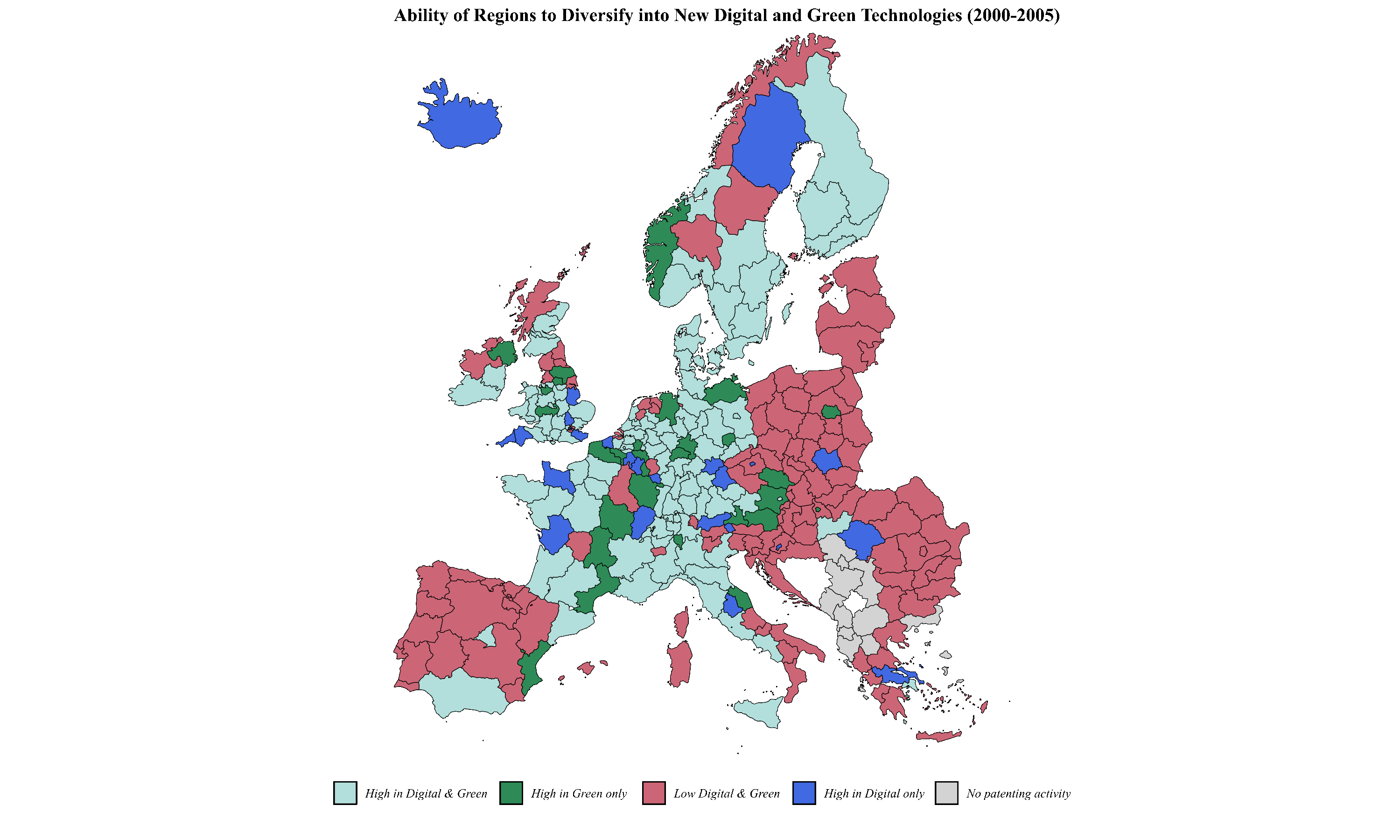Is the Twin Transition Agenda a silver bullet for global interconnected challenges?
5 June 2025

In recent years, a series of external shocks and internal crises have highlighted the growing need for transformative change. The Australian bushfires at the end of 2019 represented a remarkable example of the cumulative effects of climate change and biodiversity loss. As David Attenborough remarked, “We have been putting things off year after year. We’ve been raising targets, saying ‘oh well, if we do it in the next 20 years …’ The moment of crisis has come”. These bushfires and other external shocks were often perceived, particularly in Europe, as abstract or dystopic future concerns.
However, only weeks later, the COVID-19 pandemic spread across continents, deeply affecting European regions. The crisis severely impacted vulnerable populations, disrupted economies, and revealed how interconnected and unequal our societies remain. The war between Russia and Ukraine soon followed, sparking energy insecurity, inflation, and renewed geopolitical instability.
These events are not isolated external shocks. They are symptoms of deeper, interlinked failures. The fires, for instance, reflect the global accumulation of ecosystem degradation and climate change. Similarly, the emergence of COVID-19 is linked to biodiversity loss, increasing the likelihood of zoonotic diseases in a globalised world where such diseases propagate rapidly through dense, interconnected networks.
These overlapping crises have made three things clear. First, the threats we once imagined as distant and hypothetical are now immediate, systemic, and boundary-crossing. Europe can no longer treat them as future abstract scenarios; they require timely, coordinated responses, as the recent Spain and Portugal outage demonstrated. Second, although these shocks have been global in scope, their impacts have varied significantly across places. During the pandemic, for example, low-income regions recorded the highest mortality rates. Third, current and emerging crises are likely to amplify regional inequalities, increase social polarisation, and contribute to rising discontent and conflict.
The erosion of regional innovation capacity
Europe has also lost competitiveness, and regional disparities are growing. This challenge can be understood as the outcome of long-term economic and institutional failure. Several European regions have lost their adaptive capacity to translate scientific knowledge into technological innovation, despite growing efforts to enhance the mobility and circulation of scientists across the continent. In this regard, findings from our recent report on innovation portfolios show that although Italian regions are highly connected and contribute significantly to scientific knowledge production, many have experienced a steady decline in their innovation capabilities. This erosion of innovation capacities has led to stagnation in several regions, widened social inequalities, and weakened the overall performance of European innovation and competitiveness.
From an economic and environmental perspective, many regions – Spain, for instance – face both low economic development and high greenhouse gas emissions, increasing the likelihood of long-term environmental and public health impacts. While some regions, such as those in Scandinavia, have gradually decoupled from fossil fuels while maintaining economic growth, many high-income regions – such as parts of Germany and the Netherlands – continue to produce high emissions, expanding their environmental footprint. Other regions – mainly in Eastern Europe – remain locked into development traps, with limited capacity to shift trajectories or reconfigure existing systems, exhibiting low economic growth and greenhouse gas emissions. These patterns reflect the deeply uneven regional distribution of economic capabilities and the capacity to mitigate and adapt to boundary-crossing environmental challenges.
The Twin Transition Agenda
One of the European Union’s strategies for systemically addressing this interconnected crisis is the twin transition agenda – the convergence of digital and green transitions. Our most recent report examines whether these transitions, and their convergence, might help break existing patterns of regional inequality or further reinforce them.
Let’s first examine the digital transition. Since the Great Acceleration – the post-1950 acceleration of the human imprint on the Earth System – Information and Computational Technologies (ICT) have played a central role in shaping multiple sociotechnical systems, including energy, food, communication, and transport. These technologies are characterised by high energy intensity (often fossil fuel-based) and substantial material throughput (e.g. rare minerals), resulting in complex regional entanglements between extractive industries and ICT infrastructures.
The new generation of ICT technologies – commonly associated with the Fourth Industrial Revolution – includes robotics, artificial intelligence, advanced computing, data infrastructure, and additive manufacturing. These technologies offer significant potential to boost competitiveness, but they may also reinforce existing ICT trajectories and lock in unsustainable practices, escalating environmental impacts, and optimising incumbent systems. Furthermore, not all regions benefit equally from digitalisation, exacerbating existing inequalities and asymmetries in technological capability. A further concern is the disruptive impact on labour markets, particularly the polarisation of jobs that leads to the decline of medium-skilled occupations. Significant investment in reskilling and upskilling is essential; however, many of the most affected regions may lack the financial resources to support such efforts. Finally, the information technology productivity paradox raises questions about whether digital technologies genuinely improve productivity, or instead introduce inefficiencies by expanding our capacity to process information while reducing our ability to translate it into complex, actionable knowledge.

From a green transition perspective, there is growing concern about the insufficient progress on emissions reduction across many regions and economic sectors (e.g. housing or food), often due to institutional barriers that inhibit scaling up the implementation of green technologies. Scientific literature also highlights the uneven geography of green technology development and the increasing pressure on low- and middle-income regions to implement centralised technocratic green agendas. This has contributed to green political discontent and climate change scepticism in many territories. Lastly, there is concern about an overemphasis on technical solutions to the complex problems posed by the climate and biodiversity crises. This underscores the need for more systemic and place-based approaches that account for uncertainty and complexity in the transition process.
The key question is whether the convergence of digital and green transitions can help reduce their individual trade-offs and enhance synergies, balancing the twin transition. Digital technologies may accelerate green transitions by lowering costs, enabling decentralisation, and enhancing self-organising capabilities within green systems (e.g. circular economy). Conversely, green technologies can help mitigate the environmental impact of digital technologies by improving material circularity and increasing energy efficiency. Digital technologies can also improve our capacity to monitor and manage natural ecosystems, as seen in their expanding role in satellite imagery analysis and eco-acoustic monitoring. However, it remains unclear which regions are best positioned to benefit from these developments, and whether the social and environmental costs of deploying such technologies will ultimately deliver long-term benefits for society and the planet.
Towards place-based transformation
In summary, uncertainty remains around the outcomes of the twin transition agenda. Without careful attention, the agenda could reproduce and deepen existing regional inequalities, generating undesirable outcomes for places left behind and weakening Europe’s overall performance. It is therefore crucial to acknowledge that the twin transition, by itself, will not catalyse change. Its impact depends on our ability to develop long-term institutions capable of redirecting digital technologies toward sustainable, inclusive, and transformative pathways – making our world not only more sustainable but also more just.
As David Attenborough reminded us, the moment of crisis has come – and it is a moment for action. Moments of crisis can generate trauma, panic, economic stress, and uncertainty, but they also create opportunities to rethink what is possible. Europe’s overlapping crises have revealed the fragility of its unsustainable socio-technical systems, but they have also made one thing clear: now is the time to act by mobilising the capacities we already possess. Europe is home to one of the world’s most robust and interconnected scientific knowledge networks – an asset that must be leveraged more effectively to support regional development and inclusive innovation.
To move forward, no single formula or top-down policy approach will work for every region, as each follows different regional trajectories, as shown in our report on Twin Transitions and Innovation Portfolios. What is needed is a commitment to bottom-up experimental governance: interventions that are place-sensitive, adaptive, and rooted in local knowledge. This must be coupled with stronger mechanisms for interregional cohesion, capable of redistributing capabilities across European territories. Finally, we need formative evaluation – not merely metrics of success or ticking-box exercises, but learning tools that help us identify failures, capture unintended consequences, and recalibrate strategies in real time.
Article prepared by Oscar Y. Romero G. and Deyu Li, Utrecht University